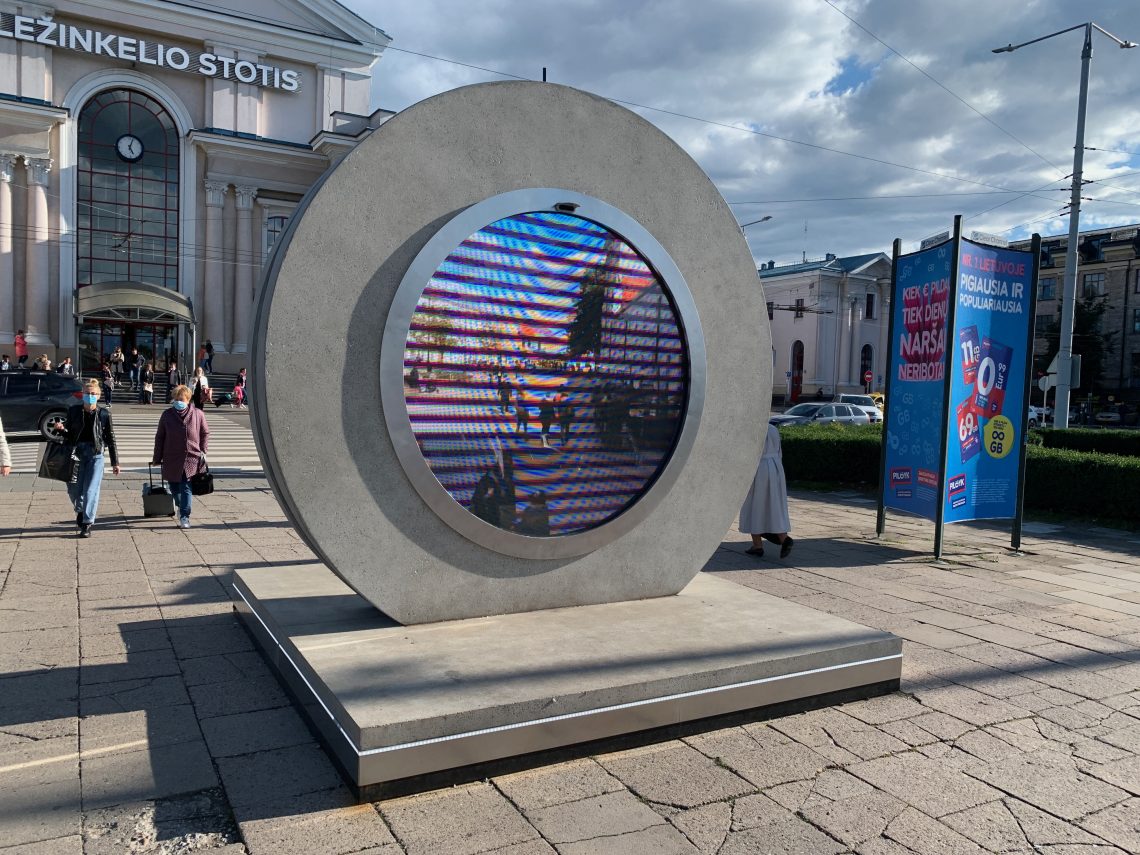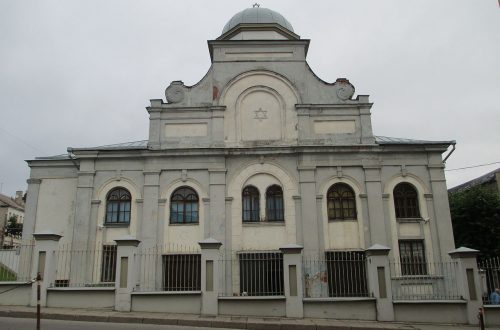
Different cities connected through the “portal” (Lublin, Poland & Vilnius, Lithuania)
On May 26th of 2021 the installation “Portal” connected two cities – Vilnius in Lithuania and Lublin in Poland, which is historically inseparable from our country. The futuristic installation turned out to be exactly what was lacking in a world tired of pandemic travel restrictions. With the slogan “Portal – a bridge to the united world” the project brings us the symbolic idea. The “portal” invites people to experience our world as it is “united and one – without borders, prejudices, and labels of us and them” – states authors of the project.
Background
An installation connecting Vilnius, the capital of Lithuania, with the Polish city Lublin is an idea by Lithuanian entrepreneur Benediktas Gylis and his foundation, implemented together with the Vilnius Gediminas Technical University (VILNIUS TECH) Creativity and Innovation Center “LinkMenų fabrikas”. The project was also supported by the Municipalities of Vilnius and Lublin cities. Information about the project was actively shared by “Go Vilnius” – the official development agency of the City of Vilnius, “Crossroads” – Center for Intercultural Creative Initiatives and the Ministry of Foreign Affairs of the Republic of Lithuania.
The main patron of the project, the Benediktas Gylys Foundation was established in 2013 with the aim to promote science, creativity, tolerance and entrepreneurship. The foundation supports creative science, various technology, and innovation projects in Lithuania. “LinkMenų fabrikas” is the Creativity and Innovation Center of Vilnius Gediminas Technical University opened in 2015. This is the first space of its kind in Lithuania dedicated to students’ creativity development. It was established to develop the competencies of future specialists, to promote cooperation between developers, researchers, and business, and to contribute to the growth of the Lithuanian economy based on innovation. It is a platform that combines study, science, and business, as well as different fields: engineering, creative industries, and entrepreneurship.
The installation “Portal” is one of the examples of the cooperation between different stakeholders in the private and public sector united by a common goal. Although the organizations do not directly operate in the cultural sector, some of their ideas can be applied even there because the projects are created by a variety of people from artists to engineers. Just as they created the futuristic installation “Portal”.
Description
The idea for the project was born before the pandemic, however, exactly this period became crucial for its implementation. The journey to the start of the international project “Portal” was long and required a huge involvement and creativity of the whole team. It was a project that needed a lot of knowledge, experience, and technological solutions (from the design, technical implementation to logistic issues) and thus, the finances. The creation and construction of both “portals” cost about 130 000 euros. The project team consisted of the engineers, designers and other creators who have developed a new way to teleport to the reality of another city in real time and get to know it up close. The “Portal” is impressive in its size – the installation weighs eleven tons and is three meters wide. Live images between the two cities were transmitted via the internet through the large screen and cameras. A circle for the screen was chosen as a well-known and recognizable sci-fi symbol for the visual “bridge”, it also has a symbolic meaning of the wheel of time. Overall, the form, design and aesthetics of the installation allow us to imagine a city of the future. Although the “Portals” are environmentally resistant, heavy, durable, and remotely controlled, the risk of vandalism remains (up to now the risk did not materialize and hopefully will not be due to people’s awareness). In Lithuania, the “portal” has been installed next to the Vilnius Train Station and in Lublin – in the city’s central square. The railway station in Vilnius is a symbolic location for the “Portal”, which invites people to travel and move to the city on the other side, encouraging them to discover new spaces in their own city. Residents are mostly accustomed to planning their life, work, and leisure time in the city center, therefore the project suggests expanding the traditional boundaries of the city, discover new centers of attraction. The project “Portal” allowed residents of Vilnius and Lublin cities to contact each other in real-time. Thanks to the technologies, the journey of Vilnius residents to the Polish city or vice versa could take just a moment.
- Video about the creation process of the “Portal” in the official Benediktas Gylys Foundation Youtube channel: https://www.youtube.com/watch?v=xi4Y7APLq4o&ab_channel=BenediktasGylysFoundation
- Video about the project “Portal” in the official BBC News Youtube channel: https://www.youtube.com/watch?v=TRvbxiCj79E&ab_channel=BBCNews
Impact
The project “Portal” spreads a message of unity, promotes friendship between different countries and gathers communities for meaningful initiatives. It gave an opportunity to people to stop for a while and think about the unknown cities and people, different cultures and in general about this world. This is especially relevant in today’s world, which is plagued by a pandemic. Installations of “Portals” in Vilnius and Lublin have become the new centers of attraction in these cities and had an impact on relations between these countries. The partner city – Lublin was chosen considering the long-term historical ties of our country with this city. As states director of the Center for International Cooperation in Lublin City Municipality, “the “Portal” reminds us that a pandemic cannot prevent the friendship, unity and international cooperation of our neighbors”. In the near future it is planned to connect Vilnius with other cities of the world through the “portals” (it is already foreseen to have “portals” in Reykjavik and London). The news about the installation “Portal”, reminiscent of doors to other worlds from the science fiction films and helping to communicate with the people of Lublin in real-time, was of great interest to the international media. More than 160 publications have appeared in the USA, Australia, Singapore, Indonesia, China, Belgium, Germany, Austria and many other countries, and the news about the project has reached an audience of more than 700 million readers. For the organizations that have implemented the project “Portal”, it was a big leap forward, allowing to believe in the limitless possibilities of humans. Subject to certain conditions, the “Portal” could operate anywhere, even in the most remote corners of the planet (it requires electricity and internet). Opportunities that seem incredible today may become a reality in the future. Especially in these times of innovation and technologies. Let’s hope we will have a possibility to see how far this project will go.
Interpretation
The installation “Portal” is an interesting, impressive, and exclusive project which received a lot of attention in Lithuania and abroad. “Only the knowledge and work of different professionals together helps to create such meaningful projects. This is another great example of what united people can do together” – states Director of the Creativity and Innovation Center of Vilnius Gediminas Technical University. Besides the futuristic image, the “Portal” also brings a meaningful message and invites us to stay united in this fragmented world.
References
- Official website of the project portalcities.org, “Portal – a bridge to the united world”, https://portalcities.org/, (accessed December 3, 2021).
- Official website of the Vilnius Gediminas Technical University vilniustech.lt, https://vilniustech.lt/linkmenu-fabrikas/naujienos-nustatymai/gruodi-duris-atveria-vgtu-linkmenu-fabrikas/104186?nid=105647 (December 1, 2015).
- Official website of the Vilnius Gediminas Technical University vilniustech.lt, https://vilniustech.lt/vilnius-tech-naujienu-portalas/naujienos/pirmas-toks-pasaulyje-portalas-vilnius-ir-liublinas-susijunge-neiprastu-virtualiu-tiltu-/246059?nid=328394 (May 26, 2021).
- Official website of Vilnius City Municipality, “Kas slypi už „Portalo“: kodėl pasirinktas stoties rajonas ir 11-a tonų betono?”, https://vilnius.lt/lt/2021/07/01/kas-slypi-uz-portalo-kodel-pasirinktas-stoties-rajonas-ir-11-a-tonu-betono/ (July 7, 2021).
Author
Header photograph
Ilja Nieuwland




